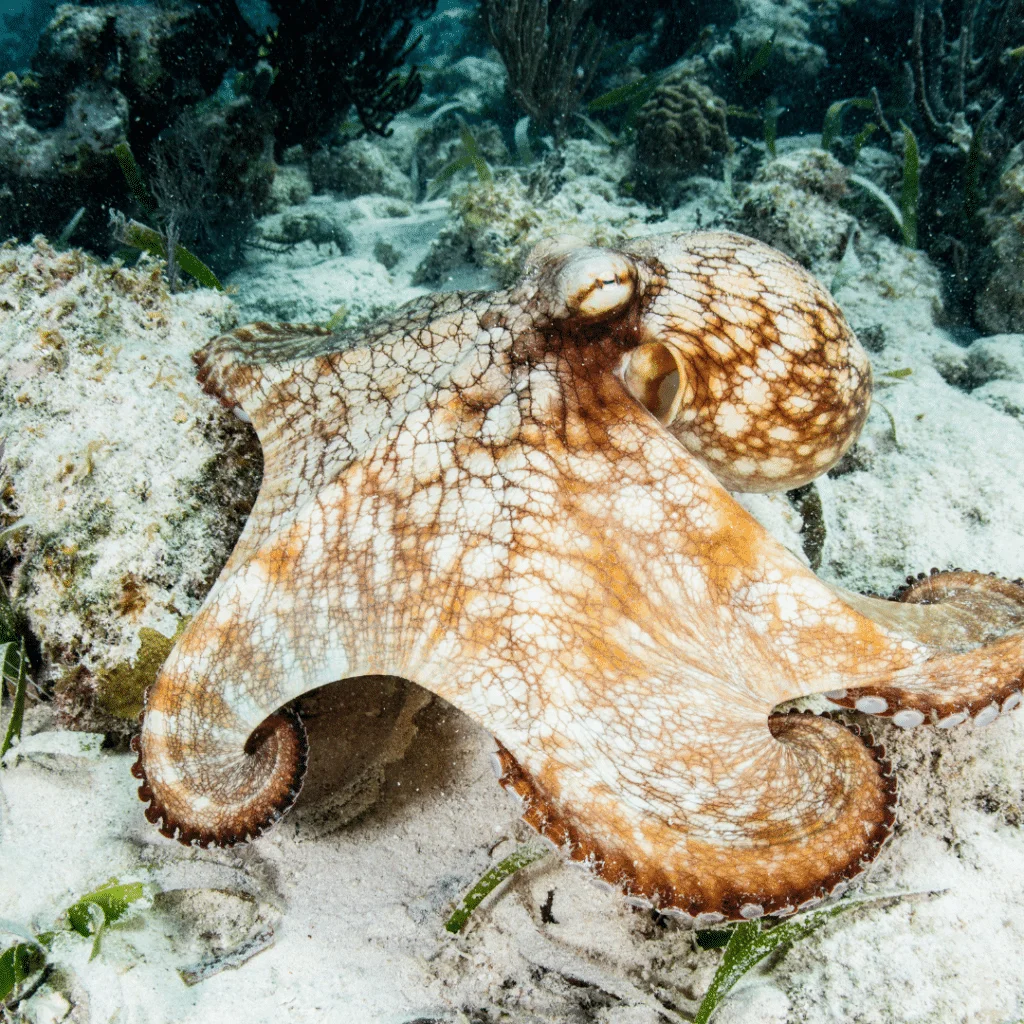As you know, our shop is called Octopus Dive School and you may have wondered how that name was chosen. Owner, Nuria, was always inspired by these amazing creatures – how smart and playful they are, their intelligence and ability to shape shift and camouflage. She found them fascinating, how they have 3 hearts, blue blood and so many tentacles that seem like connections to different souls. These were just some of the reasons that inspired her to choose the name for her dive shop. And if you have been lucky on a night dive, you may have experienced the wonder of seeing a reef octopus here in Roatan. We thought that it was about time that we dedicated a blog to these wonderful creatures.
The Caribbean reef octopus, also known by its scientific name Octopus briareus, is a species of octopus found in the warm waters of the Caribbean Sea. These octopi are known for their striking coloration, which can vary from shades of reddish-brown to light beige, with darker spots and markings.
Caribbean Reef Octopus Facts
Caribbean reef octopi can be found in a variety of habitats, including coral reefs, seagrass beds, and rocky areas.
They can grow up to 50 centimeters (20 inches) in length, with a mantle (the main body) of around 20 centimeters (8 inches) and arms that can extend up to 90 centimeters (35 inches).
They are opportunistic feeders, meaning they will eat a variety of prey depending on what is available. Their diet can include small fish, crabs, shrimp, and other crustaceans.
The female Caribbean reef octopus lays its eggs in a cluster, which they guard and tend to until they hatch. After hatching, the young octopuses are planktonic which means they drift with the currents for several weeks before settling on the seafloor.
The Caribbean reef octopus is not currently considered a threatened species, but like many marine creatures, it is vulnerable to habitat destruction, pollution, and overfishing.
The Caribbean reef octopus is known for its intelligence. They are widely recognized as one of the most intelligent invertebrates on the planet. They have a well-developed nervous system and a complex brain that allows them to exhibit a range of sophisticated behaviors.
Octopus Intelligence

The Caribbean reef octopus is known for its intelligence. They are widely recognized as one of the most intelligent invertebrates on the planet. They have a well-developed nervous system and a complex brain that allows them to exhibit a range of sophisticated behaviors.
One of the most notable features of Caribbean reef octopus intelligence is their problem-solving ability. In laboratory experiments, they have been shown to learn how to open jars and containers to obtain food, manipulate objects to create shelter, and even unscrew the caps of bottles to access prey.
Caribbean reef octopi also have impressive memory abilities and have been shown to be able to remember complex spatial layouts for weeks or even months at a time.
Another indicator of their intelligence is their ability to communicate with each other. They use a range of visual cues, such as color and posture, as well as touch and chemical signals, to communicate with other octopuses.
If you haven’t already seen it, there is an amazing documentary on Netflix called ‘My Octopus Teacher’ where an Australian filmmaker forges an unusual friendship with an octopus living in a South African kelp forest – it is a magical film!
Camouflage Abilities
The Caribbean reef octopus is also known for its impressive camouflage abilities. They can rapidly change the color, texture, and shape of their skin to blend in with their surroundings, making them difficult to spot by predators and prey alike.
Their skin contains specialized pigment cells called chromatophores, which are responsible for producing the octopus’s vivid colors. By contracting or expanding these cells, the octopus can change its color and pattern to match its surroundings or create bold, contrasting patterns to scare off predators.
In addition to chromatophores, the Caribbean reef octopus’s skin also contains specialized cells called papillae. These cells can change the texture and shape of the skin, allowing the octopus to mimic the texture of rocks, coral, and other objects in its environment.
To further enhance their camouflage abilities, Caribbean reef octopi can alter their body shape and posture to match their surroundings. They can flatten their bodies and elongate their arms to blend in with the shape of a rock or curl up and take on the appearance of a piece of coral.
All of these adaptations allow the Caribbean reef octopus to blend seamlessly into its environment, making it one of the most impressive examples of camouflage in the animal kingdom.

